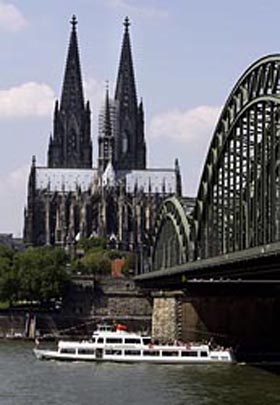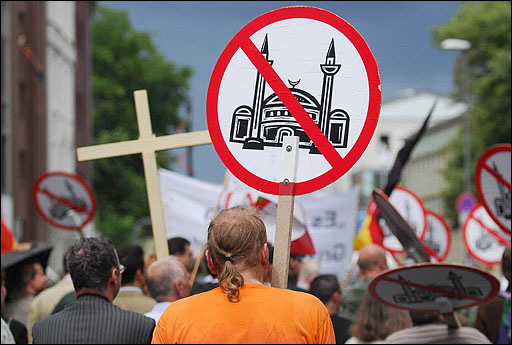Yesterday the Chicago Tribune posted a report about protests arising in Cologne, Germany regarding plans to build a new mosque in the city. The story is an object lesson in negotiating the visual public sphere. To begin with, an obviously ideological reaction is being couched in aesthetic terms: “The residents complain that the minarets would clash with the towering spires of the city’s celebrated 13th Century cathedral.”
Never mind that the two buildings would be over a mile apart and that the Gothic cathedral would be nearly three times the height of the mosque.
The reaction against the mosque moved from far-right crabbing to a full-blown public controversy once it was voiced by Ralph Giordano, “a respected German-Jewish writer” and Holocaust survivor who warned that the mosque represented “‘creeping Islamization’ of Europe.” In a radio interview Giordano observed that the sight of veiled women on the street disturbed him, and he labeled them “‘human penguins.'” You might think that a German-Jewish Holocaust survivor would be wary of stigmatizing fellow citizens by their ethno-religious garb, much less describing them as animals. Apparently the Holocaust was a long time ago. In any case, this is yet another example of how the sight of the veil in public spaces can deeply trouble the Western viewer. And sure enough, the debate about the Mosque includes arguments about, on the one hand, the “openness” of the design, and, on the other hand, how it symbolizes “isolation” and enclaved resistance to assimilation. (The Tribune included an illustration of the design in the morning paper, and it appears beautiful, open, and uplifting; unfortunately I can’t find a good copy on the Web.) Neither of these claims are in any way directly religious, but they feature a fundamental norm of the bourgeois public sphere: transparency, and not as a metaphor for institutional accountability but as an actual condition of interaction in public.
And so we get to the street, that is, to a demonstration earlier in the summer protesting construction of the mosque. This is the photograph accompanying the Tribune story:
The photo incidentally provides an outline of the planned mosque, and you can bet that the architect imagined a visual homage to the cathedral. That’s not what the demonstrator’s saw, however. The placard’s illustration deviates considerably from the architect’s drawing precisely by making the mosque appear less open, more enclaved. It also appears more traditional and less modern than the proposed design. The placard visualizes what they see, which is what they fear.
Three other features of the image also caught my attention. Because we see the backs rather than the faces of the demonstrators, they are themselves somewhat veiled, as it were, and so perhaps may appear not entirely legitimate. Second, although the red slash over a politicized image is a stock use of the “prohibited” sign from public iconography, it acquires additional meaning here: what should be an informational sign used in the neutral administration of public space has become a primal ban, the sign of fundamental exclusion from the community.
And so we get to the cross. The coincidence of the two in effect makes all the placards into crosses while turning the cross into a political tool. This is the political transformation that Giordano unleashed. And I can’t help but notice that the cross is tilting; indeed, it is starting to look like a swastika.
Getty/AFP photograph by Henning Kaiser.


Raising the the question of ‘openness’ in the response to the mosque is a strange rhetorical move, because the end result of the protests leaves the city decisively more closed. I think that’s why race and culture should be a starting point for understanding the backlash to “the Islamization of Europe” – it seems to be about openness to western values and western eyes that matters, not openness per se.
[…] seeking admission into the European Union, a process begun years ago and a prospect that arouses deep anxieties among EU member nations. Rather than emphasize a glorious past, the photograph presents the […]